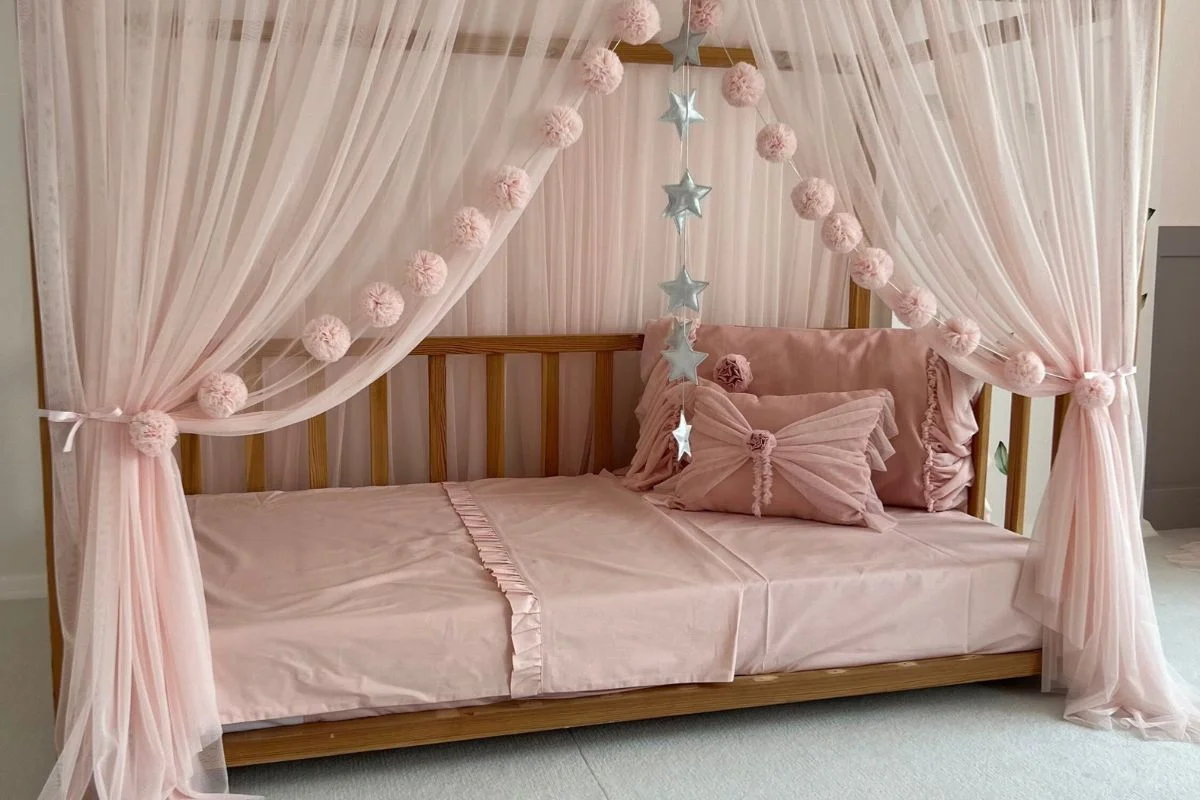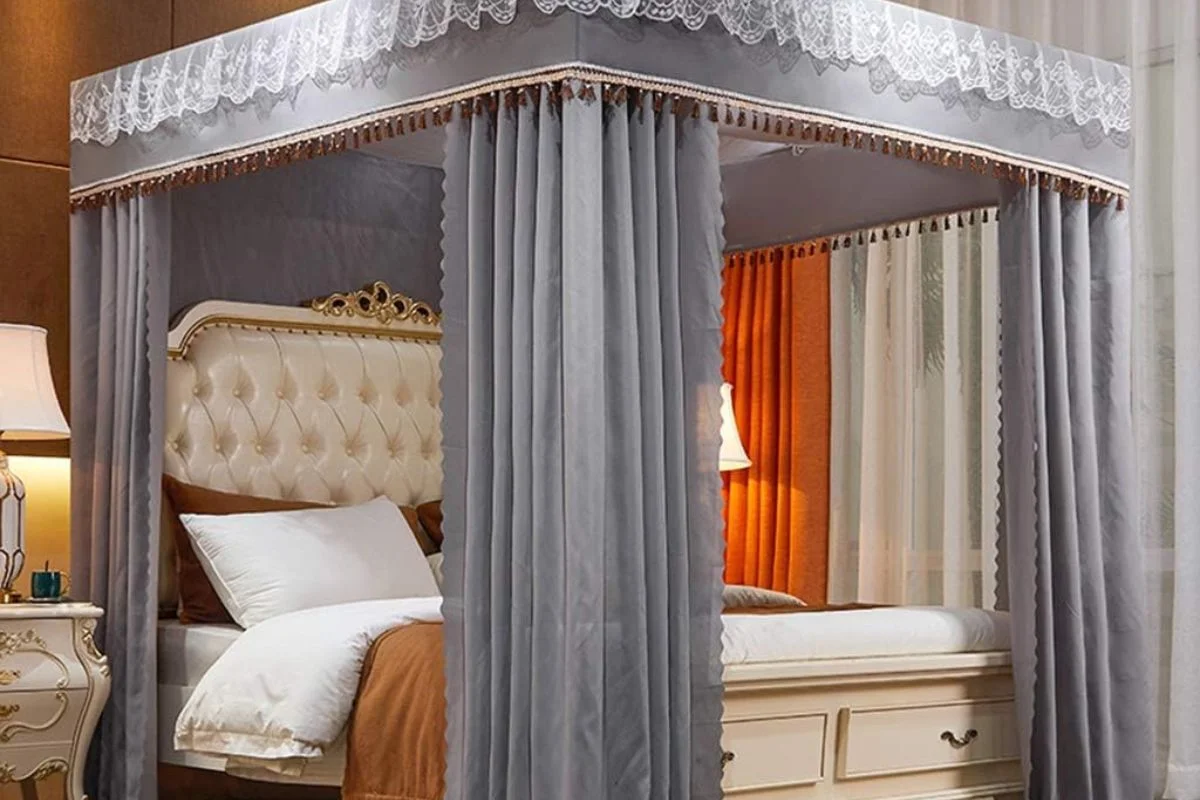In the realm of bedroom décor, the allure of bed curtains extends beyond mere aesthetics, seamlessly blending functionality with fashion. As we explore the multifaceted world of bed curtains, it becomes clear that these drapery wonders are not just decorative accents; they serve practical purposes that enhance both the visual appeal and the functionality of the bedroom space. Bed curtains, known for their versatility and ability to transform the ambiance of a room, offer more than just a touch of elegance. From providing privacy and creating a cozy cocoon to serving as practical solutions for light control, bed curtains are essential elements that marry style and substance in the bedroom. In this exploration, we delve into the practical uses of bed curtains, unraveling the ways in which these fabric adornments can elevate the functionality of your sleeping sanctuary. Whether it’s achieving a sense of intimacy, regulating room temperature, or simply adding an extra layer of comfort, bed curtains emerge as design elements that go beyond the surface, integrating seamlessly into the fabric of daily life.
Overview of the dual role of bed curtains: functional and fashionable
In the realm of bedroom décor, bed curtains stand as versatile guardians of both functionality and fashion, weaving together practicality and aesthetics to create a harmonious and inviting sleeping sanctuary. Far beyond mere embellishments, these fabric adornments serve a dual role, enhancing the overall appeal of the bedroom while fulfilling essential functions that contribute to a restful and private retreat.
Aesthetic Appeal:
Bed curtains, with their flowing drapery and soft textures, act as transformative elements that elevate the visual allure of a bedroom. They offer an opportunity to infuse the space with style, adding a layer of elegance and sophistication. Whether chosen for their luxurious fabrics, intricate patterns, or graceful silhouettes, bed curtains have the power to define the overall aesthetic of the bedroom, creating a personalized haven that reflects the occupant’s taste and design preferences.
Privacy and Intimacy:
One of the primary functions of bed curtains is to provide a sense of privacy and intimacy. In a world where personal space is cherished, these drapes act as cocooning veils, creating a secluded enclave within the bedroom. Whether fully drawn or artfully arranged, bed curtains offer a visual and tactile barrier that enhances the feeling of a private retreat, fostering a sense of comfort and seclusion.
Light Control and Ambiance:
Bed curtains play a pivotal role in regulating natural light, allowing occupants to customize the ambiance of their sleeping space. The ability to filter sunlight creates a versatile environment, from a bright and invigorating atmosphere during the day to a subdued and cozy cocoon as night falls. The interplay of light and shadow through the curtains adds a dynamic dimension to the overall aesthetic, contributing to the mood of the room.
Temperature Regulation:
Beyond their decorative role, bed curtains serve a functional purpose in temperature regulation. In colder seasons, they act as insulating layers, providing warmth and a barrier against drafts. Conversely, during warmer months, lighter fabrics and breathable designs allow for airflow, contributing to a cooler and more comfortable sleep environment. This dual functionality ensures that bed curtains are adaptable companions throughout the changing seasons.
Decorative Versatility:
Bed curtains offer a canvas for creative expression, allowing homeowners to experiment with different styles, colors, and patterns. Whether framing a four-poster bed, enveloping a canopy, or cascading gracefully around a simple bed frame, the versatility of bed curtains opens up a myriad of decorative possibilities. From bohemian chic to classic romance, the adaptability of bed curtains ensures that they seamlessly integrate into various design themes.
Practical Uses of Bed Curtains
Bed curtains, beyond their ornamental charm, serve a multitude of practical purposes that contribute to the functionality and comfort of the bedroom. From enhancing privacy to regulating light and temperature, these versatile draperies play a crucial role in creating a cozy and personalized sleeping sanctuary. Let’s delve into the practical uses of bed curtains:
Privacy Enhancement:
Secluded Retreat: Bed curtains provide an enclosed and secluded space within the bedroom, fostering a sense of privacy and intimacy. Whether drawn closed or artfully arranged, they create a personal cocoon that separates the sleeping area from the rest of the room.
Light Control:
Sunlight Regulation: Bed curtains offer a practical solution for controlling natural light. They can be drawn to block out sunlight, creating a darker and more conducive environment for restful sleep. Alternatively, they can be partially opened to allow in diffused light during the day.
Temperature Regulation:
Insulation: During colder seasons, heavy or thermal bed curtains act as insulating layers, retaining warmth and creating a cozy atmosphere. This is especially beneficial for maintaining comfort in drafty rooms and ensuring a restful night’s sleep.
Airflow: In warmer months, lighter bed curtains made from breathable fabrics facilitate airflow, preventing overheating and contributing to a cooler sleep environment.
Noise Reduction:
Sound Dampening: Thicker bed curtains can help dampen external noises, creating a quieter and more serene sleep space. This is particularly useful for bedrooms located in busy or noisy environments, providing a peaceful haven for relaxation.
Allergy Prevention:
Dust Protection: Bed curtains act as a barrier, preventing dust and airborne particles from settling directly on the bed and bedding. This can be especially beneficial for individuals with allergies, promoting a cleaner and healthier sleep environment.
Decorative Elements with Practical Impact:
Aesthetic Harmony: While bed curtains contribute to the overall aesthetic of the bedroom, their decorative aspects can also serve practical purposes. For example, a well-chosen color or pattern can conceal stains or imperfections on walls, enhancing the visual appeal of the entire room.
Versatility in Design:
Adaptability to Styles: Bed curtains offer a versatile canvas for different design styles. Whether framing a four-poster bed for a traditional look or cascading around a minimalist bed frame for a contemporary feel, their adaptability ensures they seamlessly integrate into diverse bedroom aesthetics.
Creating Zones in Shared Spaces:
Room Division: In shared bedrooms or multi-functional spaces, bed curtains can be used to visually divide the room, creating designated areas for sleep and relaxation. This practical use allows for individual privacy and personal space.
Bed Curtains for Different Bedroom Sizes and Layouts
Bed curtains, with their transformative power and versatile design, prove to be adaptable companions for bedrooms of various sizes and layouts. Whether you dwell in a cozy urban apartment or a spacious suburban home, the practical and aesthetic benefits of bed curtains can be tailored to suit your specific needs. Let’s explore how bed curtains can enhance bedrooms in different sizes and layouts:
Small Bedrooms:
Space Maximization: In smaller bedrooms, bed curtains can be utilized to create a sense of coziness and define the sleeping area within the limited space. Opting for light and sheer fabrics can maintain an airy feel while still providing a private nook.
Vertical Elegance: To draw the eye upward and give the illusion of height, consider mounting the bed curtains higher than the actual window or bed frame. This vertical emphasis can make the room feel more expansive.
Functional Separation: Bed curtains in a small bedroom can serve a dual purpose by acting as space dividers. For example, if the bedroom is a multi-functional space, bed curtains can visually separate the sleeping area from a workspace or dressing corner.
Medium-Sized Bedrooms:
Elegant Framing: In medium-sized bedrooms, bed curtains can frame the bed as a focal point, adding a touch of elegance and sophistication. Choose drapery that complements the overall color scheme and design aesthetic of the room.
Balance with Furniture: When working with medium-sized bedrooms, consider the balance between the bed curtains and other bedroom furniture. Ensure that the curtains harmonize with the size and scale of the room elements for a cohesive look.
Layering Textures: Experiment with layering textures through the use of bed curtains. Combine sheer panels with heavier drapes for a dynamic and visually appealing effect, adding depth to the overall bedroom design.
Large Bedrooms:
Grand Canopy Statements: In larger bedrooms, bed curtains can take on a more dramatic role. Consider installing a canopy bed with sumptuous curtains that cascade from above, creating a sense of opulence and grandeur.
Zoning with Curtains: Large bedrooms often feature distinct zones, such as a sleeping area, a sitting space, or even a home office. Bed curtains can be strategically used to delineate these zones, providing a sense of organization and visual appeal.
Customization Opportunities: With more space to play with, larger bedrooms allow for creative bed curtain designs. Consider customizing curtains with unique patterns, textures, or even combining different fabrics to make a bold statement.
Irregular Layouts:
Adaptability: Bedrooms with irregular layouts, such as sloped ceilings or unconventional nooks, can benefit from the adaptability of bed curtains. Custom-fit curtains can be used to accentuate unique architectural features while maintaining a cohesive design.
Corner Canopy Beds: In bedrooms with corners or alcoves, consider creating a cozy corner canopy bed with curtains. This design not only adds charm but also utilizes irregular spaces effectively.
Visual Alignment: Bed curtains can play a crucial role in visually aligning irregular layouts. By using consistent colors or patterns, they can tie together disparate elements, creating a unified and aesthetically pleasing bedroom.
Maintenance and Cleaning Tips for Bed Curtains
Maintaining the cleanliness and longevity of bed curtains requires a thoughtful approach to care. These fabric adornments, while enhancing the aesthetics of the bedroom, are susceptible to dust, stains, and wear. To ensure that your bed curtains remain fresh and beautiful, consider the following maintenance and cleaning tips:
Regular Vacuuming:
Frequency: Vacuum bed curtains regularly using a soft brush attachment to remove surface dust and prevent it from settling into the fabric.
Gentle Approach: Handle the curtains with care during vacuuming to avoid snagging or damaging the delicate fabric.
Spot Cleaning:
Immediate Action: Attend to spills or stains promptly to prevent them from setting. Blot the affected area with a clean, absorbent cloth to remove excess moisture.
Mild Cleaning Solutions: Use a mixture of mild detergent and water for spot cleaning. Test the solution on an inconspicuous area first to ensure it doesn’t affect the color or fabric.
Machine Washing:
Check Care Labels: Some bed curtains may be machine washable. Check the care labels for specific washing instructions and recommended temperatures.
Use Gentle Cycle: If machine washing is suitable, opt for a gentle cycle to prevent excessive agitation that can lead to wear and tear.
Hand Washing:
Delicate Handling: If machine washing is not recommended, hand wash the curtains in a basin or bathtub using a mild detergent.
Gentle Agitation: Gently agitate the water to cleanse the fabric without causing damage. Rinse thoroughly to remove soap residue.
Dry Cleaning:
Professional Care: For curtains with intricate details or delicate fabrics, consider professional dry cleaning. This ensures a thorough clean without risking damage.
Communicate Details: When taking bed curtains for dry cleaning, communicate any specific concerns or details to the cleaner for tailored care.
Air Drying:
Avoid Sunlight: After washing, air-dry the curtains by hanging them on a clothesline or using a gentle tumble dry cycle. Avoid direct sunlight to prevent fading.
Shape Restoration: While drying, gently reshape the curtains to maintain their original form.
Ironing:
Low Heat Setting: If ironing is necessary, use a low heat setting to avoid damaging the fabric. Place a cloth between the iron and the curtain to protect delicate materials.
Steam Option: Consider using a steamer for fabrics that may be sensitive to direct heat.
Regular Rotation:
Even Wear: Rotate bed curtains regularly to distribute wear evenly. This is particularly important for curtains that are exposed to sunlight or areas with varying temperature and humidity.
Use of Liners:
Protective Layer: Consider using curtain liners to provide an additional protective layer. Liners can help shield the curtains from dust and sunlight, preserving their quality.
Prevention is Key:
No Eating in Bed: To avoid accidental spills and stains, discourage eating in bed where applicable.
Regular Dusting: Dust the surrounding area regularly to minimize the accumulation of particles on the curtains.
Conclusion
In conclusion, bed curtains stand as both functional guardians and aesthetic focal points in the realm of bedroom decor. The dual role they play in enhancing privacy, regulating light, and contributing to the overall ambiance showcases their versatility. As we’ve explored various maintenance and cleaning tips, it becomes evident that caring for bed curtains is not just about preserving their physical condition; it’s about nurturing the atmosphere they create within the bedroom.









